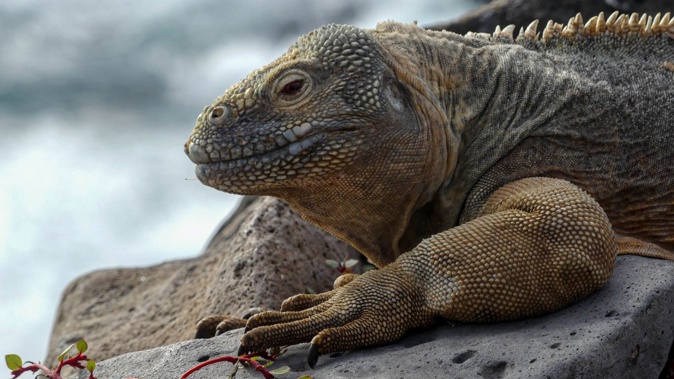
Do the Galapagos sea lions know how good they have got it? Sprawled across the pristine beaches, they wallow, snooze, and frolic across the powder-white stretches of sand, blissfully unconcerned by curious passers-by entering their slice of paradise on a goggle-eyed shore excursion. In fact, some of the sea lions waddled up to greet us into their realm of unrivalled wonder. The Galapagos grips you good, and doesn’t let go. I’m fresh back from my maiden visit to this extraordinary group of islands with Viva Expeditions, enjoying a four-night cruise aboard the magnificent La Pinta.
Recently refreshed from tip to toe, this elegant small ship is perfectly proportioned for Galapagos cruising, with a capacity for just 48 guests and over 30 crew, delivering an ultra-attentive, personable experience. My generously sized cabin had a fresh, soothing design palette, complete with floor-to-ceiling window and superb ensuite. The daily towel art was extra-imaginative. Despite being an expedition ship, La Pinta certainly doesn’t skimp on luxury comforts, adorned with sophisticated yet relaxed decks and lounges.
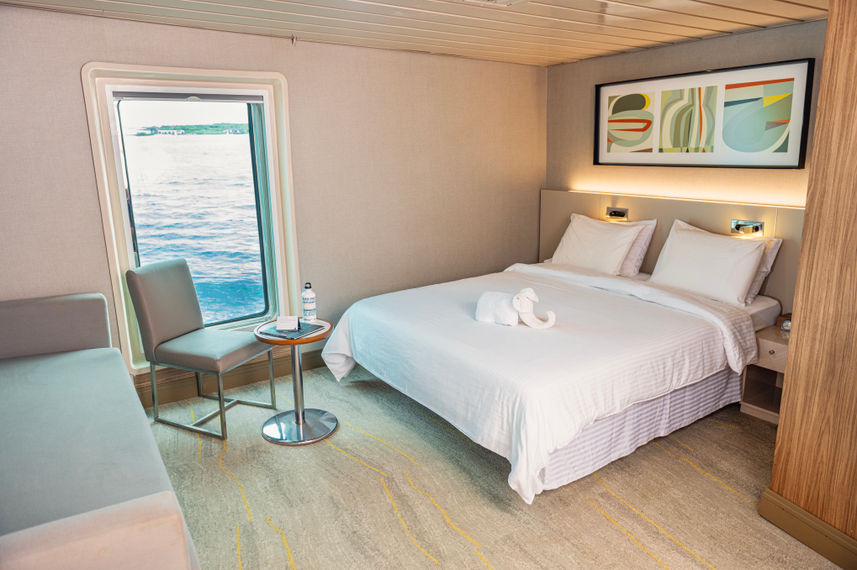 Accommodation on La Pinta. Photo / Supplied
Accommodation on La Pinta. Photo / Supplied
The canopied sun deck fast became a favourite spot to survey the scenery over a few cocktails, complete with alfresco dining area, bar and hot tub. Watching a fireball sunset torch the skyline with a brushstroke of ethereal colours, over pre-dinner drinks, became an essential twilight spectacle. The main restaurant presented exquisitely divine dining for breakfast, lunch and dinner. I feasted on so many memorable dishes, carefully curated by a Le Cordon Bleu gastronomic director. But it was the ocean-fresh seafood that constantly shone, binging on Neptune’s bounty. The supersized shrimps were commonly mistaken for prawns because they were so ginormous and bursting with flavour.
My fellow table guests featured a French male model and Hollywood actor, along with a Dutch psychiatrist. Yes, it sounds like the opening line to a joke! Swiftly bonding, we got on like a house on fire. Nature’s pulling power is magnetic with young professionals. There were so many perky thirty-somethings aboard the cruise, I felt decidedly aged! Our charismatic waiter Wilson attended to our table for every meal service, underscoring La Pinta’s winning brand of personal guest service. The sparkling Ecuadorian crew were understandably fuelled with pride in sharing their rarefied pocket of the world with us. And they were unfailingly outgoing, effervescent and hospitable.
 Cruising the Galapagos on La Pinta. Photo / Mike Yardley
Cruising the Galapagos on La Pinta. Photo / Mike Yardley
My four-night cruise began after the 90-minute flight from the Ecuadorian mainland, touching down on Baltra Island, a flat slab of rock thrust out of the ocean by geological uplift. The airport was established by the United States Air Force during WWII. The short bus ride shuttled us to the dock where we boarded one of La Pinta’s zodiacs (which are called panga in Ecuador), zipping us over to the ship. The panga rides became a fond feature of our cruise experience, because all the islands we visited entailed tendering ashore in these whip-smart zodiacs. Accentuating the experience, every shore excursion was escorted by one La Pinta’s naturalist guides, with a very small-group of guests – no bigger than 10. Sharing the experience with such a small, intimate group of fellow travellers heightened every natural encounter, immeasurably. My main guide was Alexis, who was like a male Alexa. You could ask him anything about the Galapagos and he’d deliver a commanding, enlightening answer.
My four-night cruise threaded together the eastern islands of the Galapagos archipelago, marvelling over the diverse landscapes, iridescent waters and abundant wildlife. The eastern group are the oldest islands, with the newer islands rising from the west, principally shaped by eruptions. Our first stop was South Plaza Island where the turquoise waters of the channel pop in the sunlight, contrasting dramatically with the fiery hues of the volcanic terrain. Unfurling like a magic carpet, scarlet sesuvium succulents sprawled across the lower slopes, studded with a grove of luminescent green prickly-pear cactus. It was here that I enjoyed my first rendezvous with a yellow-grey land iguana, one of the “Big 15” wildlife heroes of the Galapagos.
Their yellow colour is a result of eating so many cacti. You might even spot them rolling these prickly plants in the sand to blunt the spikes. Another South Plaza highlight was standing above the cliffs and watching the sea birds riding the thermals. Frigatebirds are a highlight here – scanning the sea for fish, swooping down to catch it in flight. The males have the most fascinating bright red throat skin sacks which inflate to form heart-shaped balloons, when courting the females.
Santa Fe Island is fawned over for its picture-perfect sandy-white beaches, heavily populated by hordes of nonchalant, cavorting sea lions. We admired the Santa Fe land iguana, another endemic species only found on this island. Fully kitted out with snorkelling equipment and wet suits by La Pinta, the sublime clarity of the water off Santa Fe was begging to be explored. The watery world revealed more majesty, with sea lions, sea turtles and dolphins frolicking amongst our group, while a vast school of tropical fish flitted about in a carnival of colour.
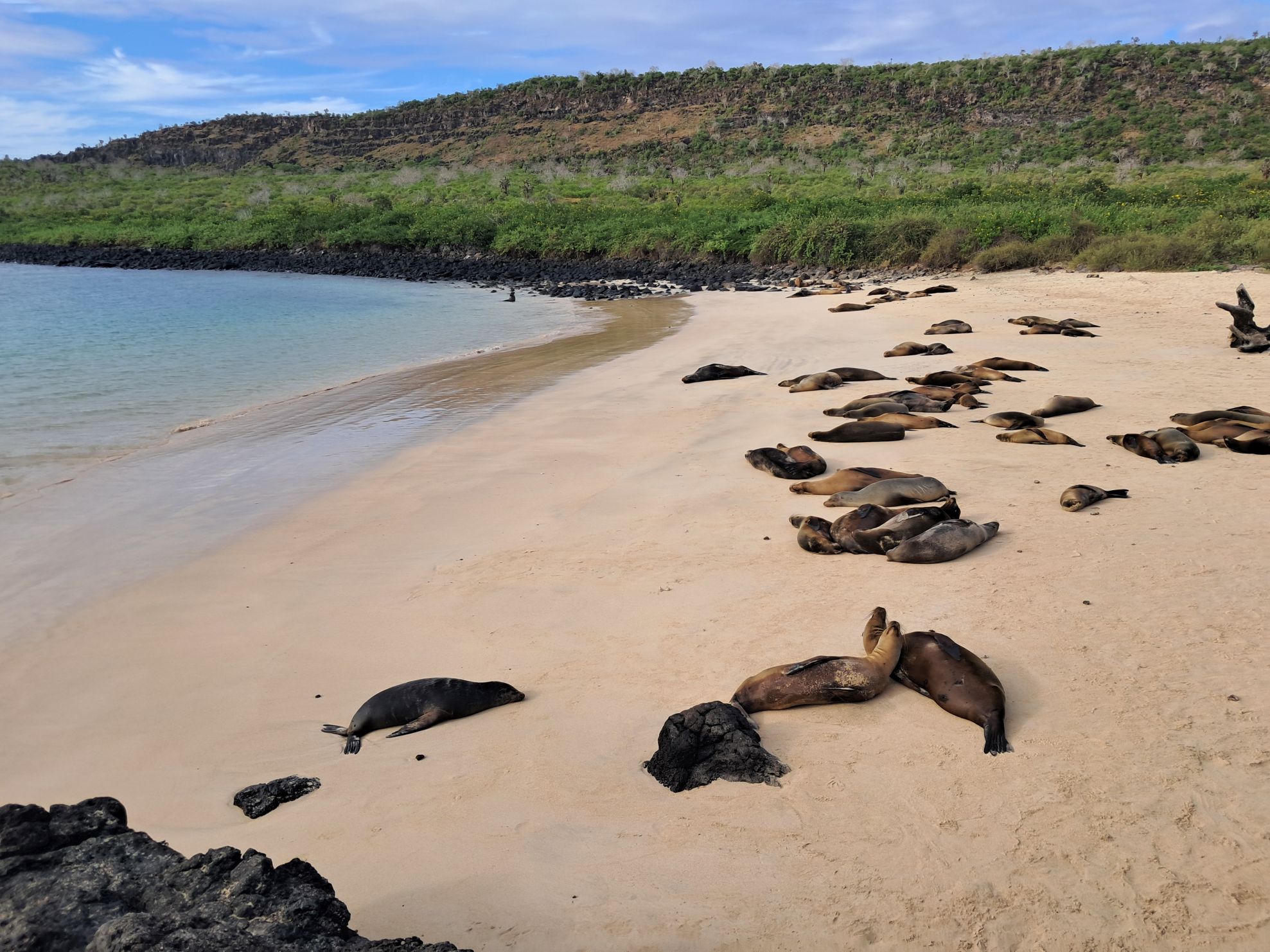 Blissed out seal lions. Photo / Mike Yardley
Blissed out seal lions. Photo / Mike Yardley
Parrot fish are prolific in these parts, and I was intrigued to learn that they are responsible for creating many of the world’s white coral sand beaches. Those powder-white sands are the result of parrot fish poop, after they have tucked into the algae or polyps that form over coral. The average parrot fish poops out 450kg of sand a year! They are the great sand-makers of the Galapagos – and elsewhere.
San Cristobal Island delivered more indelible memories, disembarking at Puerto Baquerizo Moreno, the island’s bustling, colourful capital. If Galapagos is a byword for tortoises for you, you’ll enjoy several intimate encounters with these graceful giants. My first such experience was at the Cerro Colorado Tortoise Habitat, a magnificent breeding centre for these endangered species. Their lush, deciduous forest is home to dozens of bird species including another island endemic, the San Cristobal mockingbird. A personal highlight here was ogling the marine iguana, unique to the Galapagos, and a poster child for Charles Darwin’s theory of evolution.
These lizards began life as landlubbers before spreading throughout the archipelago, with marine adaptations, grazing on submersed algae at low tide. Their striking charcoal-colouring blends in perfectly with the lava rock of the islands. Speaking of Darwin, San Cristobal Island is also home to the most astonishing white coral beach, Cerro Brujo. Darwin walked these sands back in 1835, agog by the enormous colony of sea lions and birdlife. Trying to pick your favourite island in the Galapagos is like being asked to pick your favourite child. But Española Island is a perennial heart-stealer because it throngs with so much wildlife and striking scenery.
The star of the show is the Galapagos Albatross that heavily populates this blessed island. It is the only species of albatross that lives in the tropics and not only is this bird endemic to the Galapagos, but it has the dual distinction of exclusively being found on this island. I gazed in awe watching these enormous birds take flight, walking to the edge of the cliff face and stoically hurling themselves at the sea below, in order to gain speed for flight. Once again, you can get right up close with these magnificent residents, who have no fear of people.
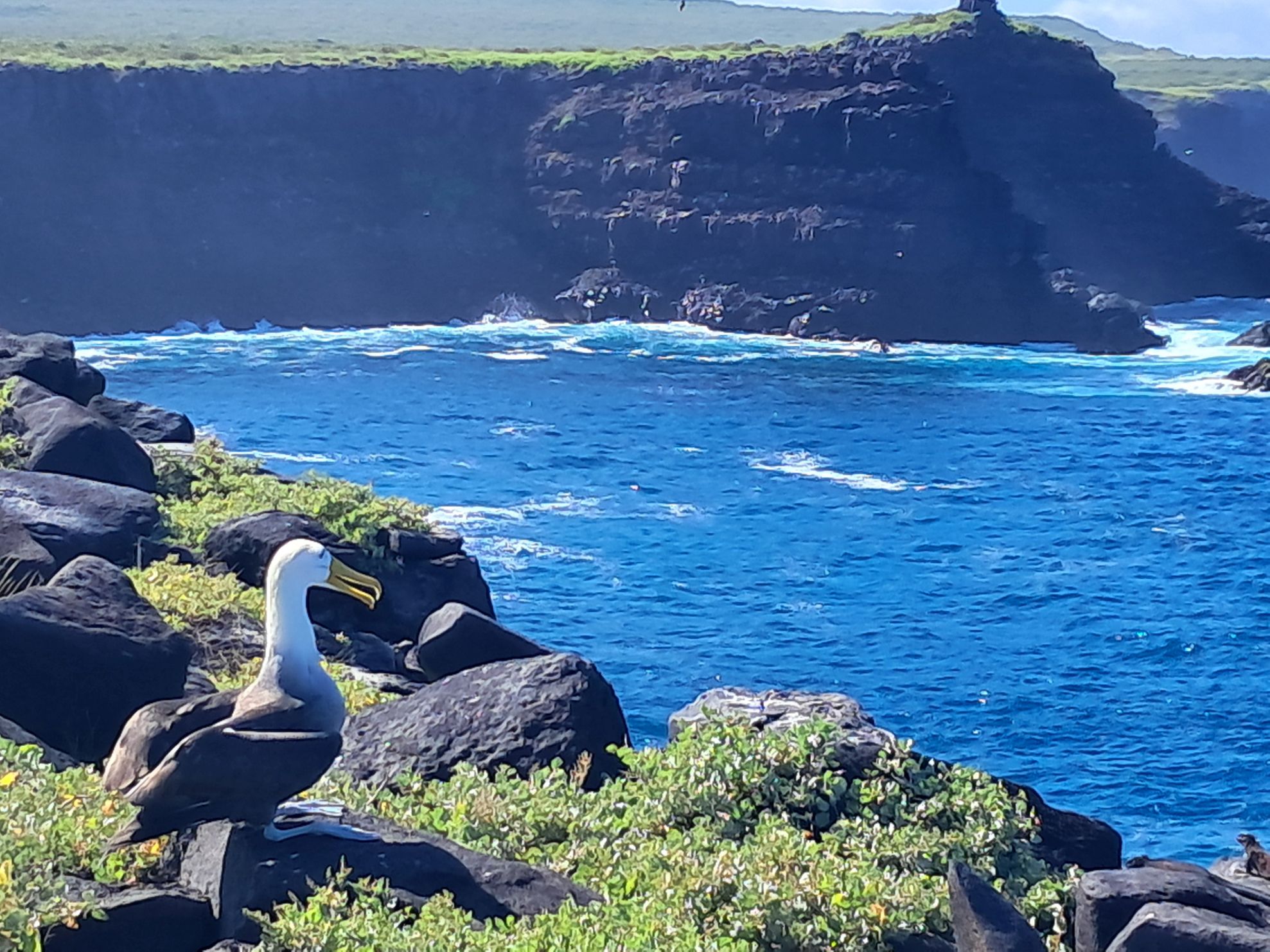 Albatross awaiting take-off on Española Island. Photo / Mike Yardley
Albatross awaiting take-off on Española Island. Photo / Mike Yardley
Backdropped by a gushing lava blowhole, another thrill at Española Island was to see so many blue-footed boobies. These clownish birds, with their electric blue feet, are comical to watch on land, because their ungainly walking style is highly reminiscent of circus clowns. But in flight, they transform into precision-hunting machines, with spectacular plunge-style dives underwater, to snare a fish. We also witnessed a mating dance, whereby the male exuberantly shows off his feet to his prospective girlfriend. Apparently, the females prefer a turquoise shade of blue to a deeper blue, and the shade of blue indicates how proficient the male is at catching fish and feeding himself.
On my last night aboard La Pinta, before disembarking for more natural glories at Santa Cruz Island, I was enjoying some night-caps in the inky darkness with some new-found British friends out on the sun deck. As we gazed down at the stern of the ship, over 30 sharks were on the prowl, circling directly beneath us, as flying fish did kamikaze acrobatic manoeuvres, playfully dicing with death. They were too quick for Jaws, but this mass-presence of sharks resolutely underscored what a wild, unplugged playground for nature the Galapagos is.
There are few places left on Earth where the wildlife shows no fear of humans, allowing you to observe it from just a couple of metres away. While on board the HMS Beagle, Darwin witnessed the Galapagos in complete isolation. La Pinta artfully keeps the faith with that supreme sense of solitude. When we stepped ashore, our small group felt like we had each island only to ourselves. It was a priceless experience with the Galapagos National Park – a living laboratory of evolution and scientific discovery, where the wildlife runs free. Swarming with sharks, crawling with critters, aflutter with remarkable birdlife, surrender to the primal pull of this striking archipelago. A Galapagos cruise is not just enticing, or addictive, but transformative.
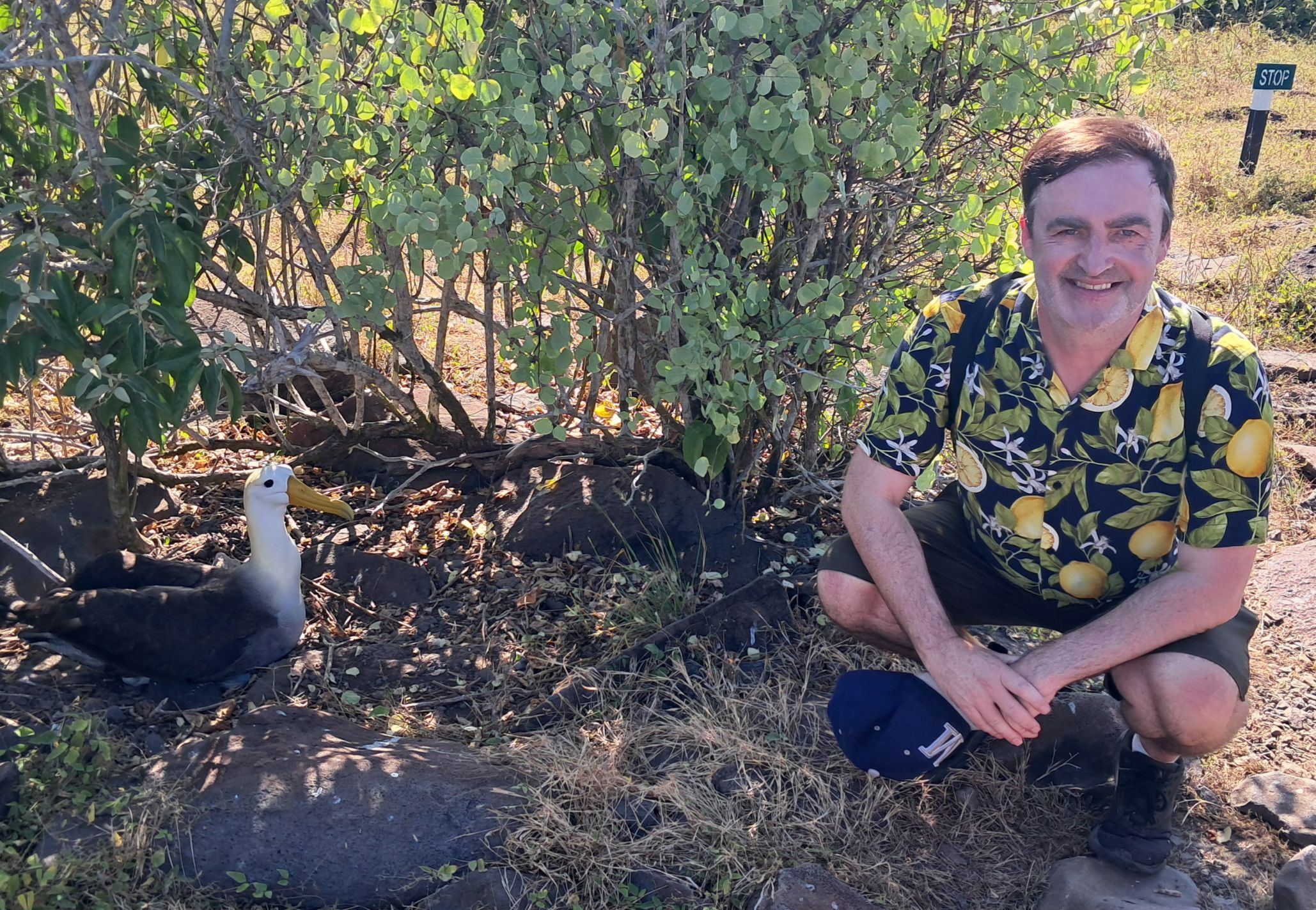 Albattross encounters on Española Island. Photo / Mike Yardley
Albattross encounters on Española Island. Photo / Mike Yardley
I travelled to the Galapagos with Viva Expeditions who know Ecuador and South America inside-out. Their ground partners, Metropolitan Touring, boast an incomparable portfolio of luxury Ecuadoran travel products and experiences, including La Pinta cruises in the Galapagos. With Viva Expeditions, you’ll enjoy premium, meaningful travel experiences, with a down-to-earth approach. You’ll meet local people, experience authentic food and culture and stay in distinctive accommodation. Viva’s 24/7 on-the-ground local support and expertise ensures you’ll be safe and secure. Explore Ecuador and beyond with New Zealand’s proven experts in travel to South America. vivaexpeditions.com
Jet your way to Ecuador with LATAM. Latin America’s leading airline group connects Brazil, Chile, Colombia, Ecuador and Peru with the world, including direct flights from Auckland to Santiago, with onward connections to Quito. latam.com
Explore the world with the trusted name in travel insurance, Cover-More Travel Insurance, which has you covered with added safeguards, over and above the typical travel cover, for the likes of medical treatment. In addition to single-trip cover, multi-trip annual cover is another great option, wherever you want to go. Check out the full range of protections and tailor the level of cover to your requirements. Cover-More’s 24 hour global assistance centre is just a phone call away. covermore.co.nz
Mike Yardley is Newstalk ZB’s resident traveller and can be heard every week at 11.20am on Saturday Mornings with Jack Tame.
Take your Radio, Podcasts and Music with you









